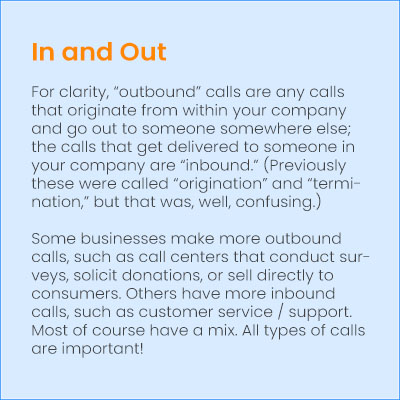How They Work and Why You Need All Three
Since phones became a critical component of business operations 100+ years ago, whole industries have sprung up explicitly around their use, while many others have become revenue dependent on the ability to make and receive calls. Although rare, telecom outages are a serious issue for most companies.
A dated Gartner Group estimated that a major outage costs companies an average of $5,600 per minute. It’s likely three times that in 2024. Outages have been known to last for days; that’s some serious math! If the outage is more isolated, the speed of the fix might also be dependent on how responsive your provider’s support team is and/or how important your business is to their bottom line. While some of your company’s revenue loss might be recuperated, some is gone forever. Worse yet, some of your customers and prospects will be gone, as well. If an outage isn’t widely publicized, people who can’t get through are likely to blame your company.
Before cloud communications and Voice over IP (VoIP) came along, we generally had a single provider and so an outage just was what it was; there was nothing we could do about it. Since the advent of VoIP, however, along with numerous carriers and literally thousands of providers, our calling options have expanded and we’re expected to have a disaster recovery plan that keeps the phone calls flowing.
 There are a lot of factors that go into ensuring calls are delivered correctly and with good audio quality, from hardware and software to proper testing and rollout. When an issue is minor, chances are your provider or carrier has mechanisms to reroute around the outage and no one’s the wiser. Because the stakes are so high, though, companies are choosing to have coverage via multiple sources “just in case”—a.k.a., redundancy. But what exactly does that mean?
There are a lot of factors that go into ensuring calls are delivered correctly and with good audio quality, from hardware and software to proper testing and rollout. When an issue is minor, chances are your provider or carrier has mechanisms to reroute around the outage and no one’s the wiser. Because the stakes are so high, though, companies are choosing to have coverage via multiple sources “just in case”—a.k.a., redundancy. But what exactly does that mean?
Outbound Redundancy
Calls are typically protected by both network redundancy and carrier redundancy. Network redundancy covers things like duplicate data centers, so that if one goes down then traffic is rerouted through another; these types of protection are fairly standard. Carrier redundancy is a company’s use of multiple VoIP providers / carriers so that if one carrier has a problem, calls are easily switched to another.
A provider may also be a carrier and work with multiple carriers, as well, reducing the odds that their customers even know there was an outage—calls are simply rerouted at the first sign of trouble. However, many providers use only one and their choice of carrier(s) may even be proprietary: you don’t know who’s handling your calls. (Commio is unique in that we not only offer a choice of up to 40+ carriers, companies can pick and choose which ones they prefer; they can also see where a call was routed and switch carriers in real time if necessary, with just a click.) To ensure access to multiple carriers in the advent of a problem, many companies establish a backup provider(s).
All of that said…when the telecom industry refers to carrier redundancy, most of them really mean outbound redundancy—because inbound redundancy is more complicated and very few providers offer it, including inbound toll-free redundancy.
Toll-Free Redundancy
Outbound redundancy is great, but if inbound calls and Service Level Agreements (SLAs) are critical for your organization, outbound protection just isn’t enough. Customer service support centers are perhaps the most obvious example of a business that relies on inbound calls, but insurance, hospitality, travel, utility, legal and financial services, and healthcare providers are just a few of the many examples. In the case of healthcare, an inbound call outage not only hurts the bottom line but can also be life threatening!
Most providers would have you believe that if a carrier goes down, there’s nothing you can do about the inbound calls you miss—but inbound redundancy is in fact possible. Because toll-free calls are routed somewhat differently than regular phone calls, however, let’s start with toll-free.
Most people know toll-free numbers are special phone numbers that start with specific prefixes such as 1-800 and allow customers with landlines to call a company without incurring any long-distance charges. Although the charges are less relevant today with fewer landlines, they’re also a good way to encourage brand recognition (think 1-800-FLOWERS or 1-800-GOTJUNK).
A company named Somos manages the databases for both “regular” (ten-digit with area code) and toll-free numbers, as well as certifies “responsible organizations,” or Resporgs, to manage and administer a subset of the toll-free numbers. Most Resporgs are telecom providers, and if your company has a toll-free number(s) you should use a provider that’s a Resporg.
Resporg providers that offer inbound toll-free carrier redundancy typically handle it similarly to providers that offer outbound redundancy—i.e., multiple carriers. You will still need to identify the issue (phones are suddenly very quiet, or customers tip you off: “Hey, I keep trying to call!”); you then file a support ticket and they’ll switch you to a new carrier as soon as they’re able. However, unlike outbound redundancy, you can’t simply set up multiple backup providers / carriers proactively; you must choose from the select few that offer this service. If you switch when there’s an issue, you’ll need to wait a few days for your numbers to be ported.
Commio is a Resporg and one of those few providers offering toll-free carrier redundancy, but also has additional capabilities. As with Commio’s outbound redundancy, “Smart Toll-Free” is the only option that lets you pick and choose from among all five tier-one toll-free carriers, have visibility into your call routes, and change carriers in real time. Simple as that! (Of course the customer success team is also standing by if you need their assistance.)
Inbound Redundancy
Incoming phone calls to standard phone numbers (that is, 10-digit DIDs that aren’t toll-free) are not protected from outages with any provider other than Commio. If these numbers stop receiving inbound calls due to a carrier outage, a trouble ticket will need to be raised with your provider and then you wait for a response. Which typically is, “Carrier xyz has an outage and we will provide updates.” The only other option is to port the numbers out to an all-new provider; but that solution could also take days.
However, if Commio is your provider and you contact us because you’re missing calls, we can reroute to a different carrier within minutes: approximately five minutes for the first number, and more quickly for additional DIDs.
Do You Need More Redundancy?
To reiterate, outages are rare. The carriers are very good at handling calls, and you might not ever need carrier redundancy. But that’s no consolation when an outage happens, inbound or outbound. Shareholders don’t want to hear that “our carrier is normally quite good!” At the very least, you need to calculate how an outbound, inbound, or toll-free outage would affect your bottom line for an hour…two hours…or several days…and determine whether your company can afford to take that hit.
You have a variety of provider / carrier options for outbound redundancy, but if you need inbound redundancy and/or smart toll-free, you will want to contact Commio. (And if you want to choose from among 40+ carriers or re-route calls in real time, call us for outbound, as well!)


















